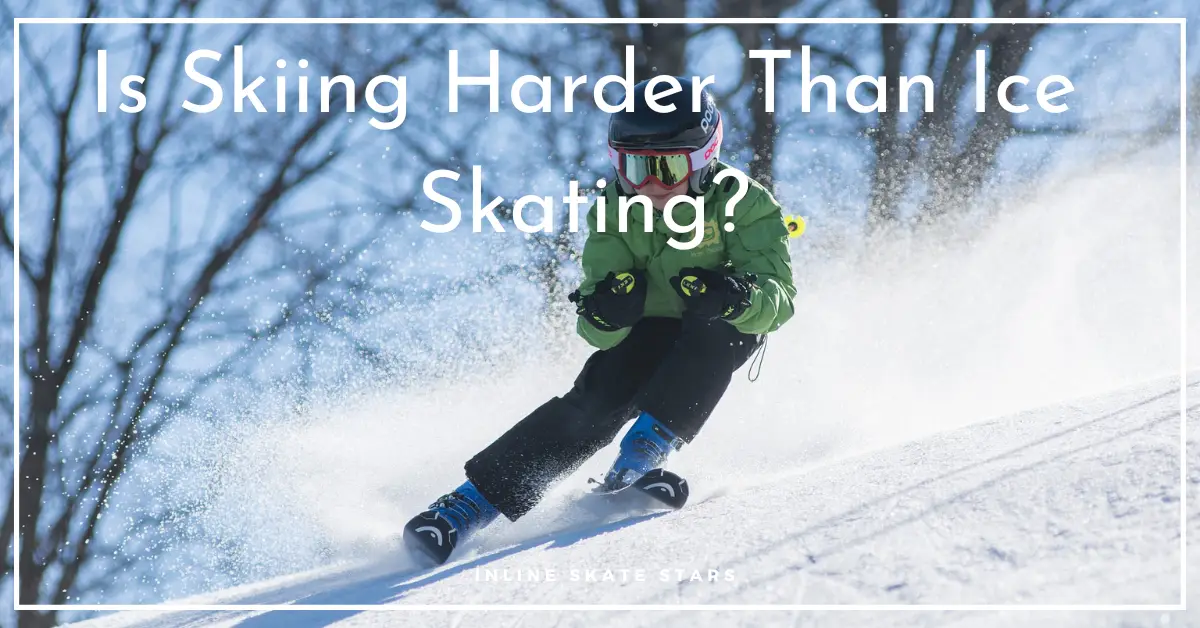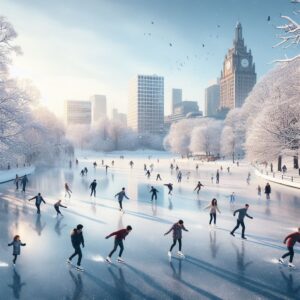Ice skating and skiing winter sports demand physical strength, balance, coordination, and endurance.
The two sports are similar in technique, yet skiing proves to be hard.
In this article, l will cover how skiing is more demanding than ice skating.
Is Skiing Harder Than Ice Skating?
Is skiing harder than ice skating? Skiing is harder than Ice skating because of the following reasons;
- Skiing is hard to perform tricks and techniques, especially in bad weather.
- Skiers find balancing and coordination more physically demanding.
- Skiing is difficult to learn for beginners.
- Skiing environmental risks and injuries pose a challenge. It’s unlike ice skating, where the skating environment is relatively less risky and beginner-friendly.
Below I elaborate further.
1. Learning to Ski is Harder for Beginners
Beginners find learning to ski hard compared to ice skating.
Skiing requires more coordination and balance, as well as a higher level of fitness and strength.
Ice skating, in opposition, is a bit more forgiving and learning relatively quick.
Skiers need to learn to control: speed, direction, turn, stop, ski in different snow conditions, and navigate around obstacles.
Skiing also requires skis, poles, and boots, which can be challenging for beginners.
The tools can be risky and difficult to ski without an expert guide.
As Ice skating is beginner-friendly, skating on ice demands a sharp level of coordination, balance, and proper use of the blade skates.
Blade skates are not intimidating because they are more or less like regular shoes.
However, learning to ski or ice skate largely depends on the individual and their level of coordination, strength, and experience.
Ice skaters with enough experience may find skiing easy because essential Ice skating lessons make skiing easier.
2. Skiing Environment Is Challenging for Skiers Compared to Ice Skating Environment
Although both Ice skating and skiing take place in cold and icy environments, Ice skating is more exhilarating and serene.
Ice skating occurs on artificial or natural ice turf, while skiing is on slopes, mountains, and snow hills.
When the weather gets too cold, it can significantly affect your ability to ski.
The cold can cause the snow to harden, making it more difficult to turn and control your skis.
It can also make your equipment less effective, as the cold can cause the bindings to freeze and the skis to lose their way.
In addition, the cold can affect your physical condition, making it more challenging to stay warm and function properly.
All these factors can make it more challenging to enjoy skiing in the cold weather.
3. Movement and Tricks in Skiing Is Hard
Skiing involves propelling oneself forward using skis, while ice skating involves gliding across the Ice on blades.
The difference in movement is because of the different equipment used in each sport.
Skis provide traction and stability, while ice skaters’ blades are designed for speed and maneuverability.
The different movements required in each sport also result in different muscles working.
Skiing uses muscles in the legs and lower body, while ice skating uses powers in the arms, legs, and core.
Skiing and ice skating are excellent forms of exercise, but the distinct movements required make them each unique.
The common stopping techniques in skiing are:
Skiing is a great way to get outside and enjoy the winter scenery. Therefore, bad weather, like heavy snow, can make skiing hard.
For one, skiing boots and ski boards (freestyle boards, powder boards, and all-mountain boards) are heavier and may challenge movement and skiing tricks in deep snow than ice skates on rinks.
Skiers must be physically fit to use them.
4. Skiing Techniques Are Hard
Regarding techniques, stopping while skiing can be challenging depending on speed and the ski board size used, mainly because of the terrain.
To stop correctly, skiers must use edges to dig into the snow and slow themselves down, which takes a lot of strength and control.
- The snowplow stop-which is when the skater or skier digs the edges of their skis or blades into the snow to slow down or stop.
- The stem stop—is when the skater or skier uses the middle of their skis or blades to slow down or stop.
- And others like the hockey stop, the wedge stop, and the sit stop.
Although these stopping techniques are present in ice skating, they are more physically demanding while skiing.
Techniques like turning and jumping, too, require a lot of practice and control.
To jump appropriately, you must take off from the lip of the jump, using your momentum to carry you into the air.
Then, you must tuck your legs and land smoothly on the other side. This takes practice and timing.
Also, the use of skiing equipment poses challenges for skiers. Skiers often use specialized equipment such as skis, ski boots, spades, and poles to ski.
For example, Alpine skiing requires the use of skis that are designed for downhill skiing, while Nordic skiing requires the use of skis that are designed for cross-country skiing.
Nordic skiing also requires poles, which are absent in Alpine skiing.
Alpine skiing is done on slopes covered in snow, while Nordic skiing is on any flat surface, including snow-covered fields and forests.
It can be challenging for skiers to move using skiing equipment.
In ice skating, the only equipment skaters uses are blade skates and Ice skating protective gear.
The two main types of movement in ice skating are edges and turns.
Edges are performed when the skate blade is placed on the Ice at an angle, while turns are achieved when the blade is placed flat on the surface.
In short, skiing is more technical than ice skating and requires more balance, endurance, strength, and agility.
5. Skiing Is Risky and Injury Prone
The nature of skiing environments and skiing equipment makes it risky.
Skiing accidents can happen in several ways, but the most common are collisions with other skiers, falling, or hitting a tree or other object.
Skiing is also a high-impact sport, so injuries to the knees, hips, and back are not uncommon.
Skiing equipment is risky because it is expensive and dangerous if not used correctly.
Skiing equipment can also be dangerous if it is not well-maintained.
In ice skating, risks and injuries expectation is less since poles and trees are not involved.
Although, Ice skating risks are almost the same as skiing.
Cold temperatures, too, affect the snow, making it harder and more brittle.
Therefore, making skiing more difficult and dangerous. It is important to be aware of the conditions before heading out.
In extreme cold, avalanches may occur, so it is vital to take extra precautions in areas prone to them.
Here are the results of extreme temperatures:
First, cold temperatures can shock your system if you’re not used to them.
To avoid hypothermia, skiers dress in layers and try to stay hydrated.
Second, the snow and Ice can create slippery conditions that make it easy to fall.
Be sure to take it slow at first and wear proper footwear to avoid slipping and injuring yourself.
Finally, the winter weather can also create visibility issues. Fog, snow, and rain make it difficult to see where you’re going.
Be sure to take breaks often and stay aware of your surroundings to avoid getting lost or hitting a tree.
However, by following simple safety tips, skiers can enjoy a fun and safe day on the slopes!




